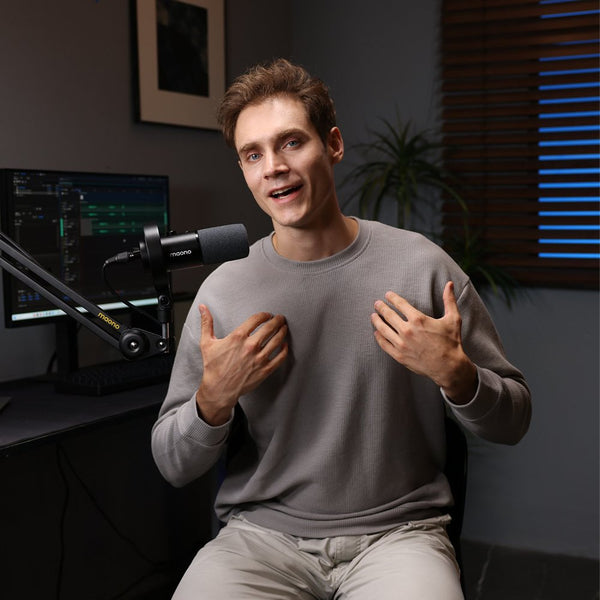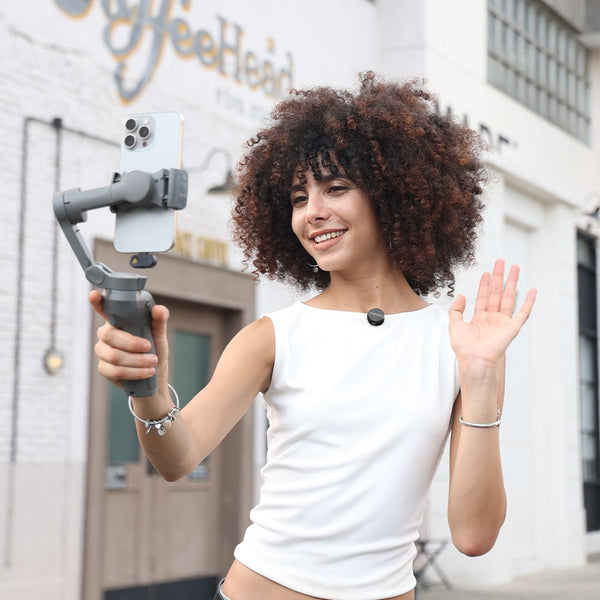Did you know that a high-protein meal can aid in weight loss while also supporting muscle growth? Let's explore how resistance training can help you achieve your weight loss goals, and how you can vlog your fitness journey using a wireless microphone.
Nowadays, vlogging has become common across various social media platforms, and one of the most popular trending topics—both in video content and podcasts—is fitness. Vlogging your fitness journey can be a powerful way to motivate others and stay accountable to your goals. Whether you're aiming to lose fat, build muscle, or simply share your health expertise, combining strength training with smart nutrition and crystal-clear audio can set your content apart.
Using a wireless microphone system during workouts and cooking demos adds a professional touch and ensures your voice comes through—no matter how active you get. This guide will help you understand how to create compelling vlogs that blend muscle-building meals, resistance workouts, and audio tips using a wireless microphone for iPhone or other mobile setups—perfect for personal trainers, gym-goers, and health coaches looking to level up their content.
Why Protein Intake Is Crucial for Fat Loss and Muscle Preservation
Protein is essential not just for building muscle, but also for protecting it while losing fat. When you're in a calorie deficit, your body may turn to muscle tissue for energy unless protein intake is sufficient.
Vloggers can emphasize this message by:
-
Showing examples of high-protein meals
-
Explaining how to calculate daily protein needs (typically 0.8–1.2g per pound of body weight)
-
Sharing personal progress tracking muscle tone and weight
Good vlogs balance visual appeal (like plated meals or before/after shots) with informative voiceovers. These are easiest to capture using a wireless clip on microphone while you're cooking or demonstrating your fitness routines.
The Benefits of Strength Training
Strength training (also sometimes called “resistance training”) is a game-changer for fat loss because it helps build lean muscle, which burns more calories at rest. Compared to cardio, it promotes longer-term metabolic health and body recomposition.
Fitness vloggers can share:
-
Resistance band routines
-
Dumbbell home workouts
-
Weightlifting form tips
-
Weekly strength split programs
Combining video footage with voice explanations using the best wireless microphone during sessions enables you to provide clear instruction and motivation, without the audio drop-offs or background noise typical of onboard mics..
Wireless Mic Tips for Filming Resistance Workouts and Nutrition Guides
Background noise, echo, or faint audio can ruin great vlog content. This is why using the best wireless Lavalier microphone like the Maono Wave T5 is a must for any mobile fitness creator.
Here’s how to make the most of your wireless microphone system:
-
Position your mic clip securely
Attach the mic to your collar or tank strap to keep it close to your mouth.
-
Use noise-cancellation/noise-reduction features
Choose a mic with built-in noise cancellation, especially when filming outdoors or in noisy gyms.
-
Wind protection
For outdoor vlogs, add a foam windscreen/windproof to reduce interference.
-
Dual-transmitter mic systems
Perfect for collaborations or interviews.
The Maono Wave T5 wireless mic offers real-time monitoring, long battery life, and mobile compatibility—ideal for voice clarity during active movement and voice overs in the kitchen.
Creating Engaging Fitness Vlogs: Wireless Audio Setup and Content Ideas
Whether you're just starting or growing your brand, creating high-quality fitness vlogs doesn’t require a studio. Here’s what you need:
-
Smartphone or mirrorless camera
-
Tripod or stabilizer
-
Wireless microphone for iPhone (e.g., Maono Wave T5)
-
Basic lighting (natural or ring light)
Content ideas that work well with wireless audio:
-
Time-lapse of your weekly meal prep
-
Full-length resistance workouts with real-time cueing
-
Talking-head updates sharing personal fitness goals
-
High-protein grocery hauls with nutritional breakdowns
-
Day-in-the-life vlogs: eating + training routines
FAQs on Protein & Diet for Weight Loss:
1. How much protein should I eat daily to lose fat and keep muscle?
Aim for 0.8 to 1.2 grams of protein per pound of body weight depending on activity level and body composition goals.
2. What are high-protein meals that support resistance training?
Grilled chicken breast with quinoa, tofu stir-fry, protein smoothies with Greek yogurt, lentils with eggs, and salmon bowls.
3. Can eating too little protein slow down weight loss progress?
Yes. Insufficient protein can lead to muscle loss, which reduces your resting metabolic rate and hinders fat loss.
4. When is the best time to eat protein for muscle recovery?
Consume 20–30g of protein within 30–60 minutes post-workout for optimal recovery and muscle protein synthesis.
5. What’s the difference between animal and plant protein for fat loss?
Both support fat loss. Animal proteins are complete sources, but combining plant proteins (e.g., beans + rice) can also cover amino acid needs.
6. Why am I gaining weight when I’ve increased protein and started strength training?
You may be gaining muscle, which is denser than fat. Focus on body composition, not just scale weight.
7. How do I stay consistent with protein intake and resistance workouts for long-term fat loss?
Track meals with apps like MyFitnessPal, plan workout schedules in advance, and stay accountable via vlogging or online fitness communities.
Common Questions on Resistance Training:
1. How does resistance training help with fat loss compared to cardio?
It builds muscle, increasing basal metabolism. Unlike cardio, the calorie burn from resistance training continues after the workout ends.
2. How many days a week should I do resistance training for weight loss?
3–5 days per week is ideal. You can alternate muscle groups to avoid overtraining.
3. Will lifting weights make me bulky instead of lean?
No. Muscle gain is slow, especially for women. Strength training helps create a lean, toned appearance.
4. Can I lose weight without cardio if I do strength training and eat protein?
Absolutely. Fat loss depends more on diet and muscle retention than cardio. Cardio can still enhance heart health and aid recovery.
5. How soon will I see results from combining protein and resistance workouts?
With consistency, you may see visual changes in 4–6 weeks, with improved strength and energy noticeable even sooner.
6. What are some examples of strength training exercises?
-
Squats
-
Deadlifts
-
Push-ups
-
Pull-ups
-
Lunges
-
Overhead presses
-
Rows
Record these with your wireless clip on microphone to explain techniques clearly and keep viewers engaged.
On Vlog Content Creation
1. What type of content should I focus on: meal preps or gym workouts?
Both! Alternate between them weekly to appeal to different viewer interests. Combining both in a single vlog also works well.
2. How do I create short-form vlogs showing my weight loss progress?
Use 30–90 second Reels or TikToks to highlight visual progress, workouts, or meals with voiceovers captured via a wireless microphone system.
3. Can I use my wireless mic to record both talking and workout sounds?
Yes. Just ensure the mic isn’t brushing against your clothing. Some mics can capture ambient gym sounds without overpowering your voice.
4. How do fitness vloggers keep their audience engaged with nutrition tips?
By using relatable language, visual explanations (like pie charts for macros), storytelling, and clear, enthusiastic audio delivery.
FAQs on Vlogging with a Wireless Mic:
1. What are tips for keeping your wireless mic stable during workouts?
-
Use a sturdy lapel clip
-
Position the transmitter securely on a waistband or armband
-
Tape down the wire if needed to avoid flapping during movement
2. How do you film cooking or meal prep with a wireless mic for voice clarity?
Mount the mic on your upper shirt near your mouth. Use noise reduction and stay away from loud appliances when speaking.
3. What’s the best wireless microphone for recording resistance workouts?
The Maono Wave T5 Wireless Microphone is a top choice for creators.
Why it’s ideal for fitness vloggers:
-
Dual transmitters for interviews or dual angles
-
Voice filters and Noise cancellation adjustment via the Maono link app
-
Long battery life (9+ hours on one charge, 30 hours with the charging case)
-
Excellent noise suppression for gym or outdoor use
-
Compatible with smartphones, cameras, and laptops
-
Compact and lightweight
Its reliability and professional audio quality make it the best wireless microphone for creators on the go.

Conclusion
Whether you’re a personal trainer, health enthusiast, or nutrition coach, fitness vlogging is a powerful platform to inspire and educate others. While visuals matter, it’s clear audio from a wireless microphone that keeps your audience tuned in.
Your vlogs can motivate and guide others on their fitness journey by addressing relevant topics and focusing on high-protein meals, strength training, and using a clean, wireless audio setup. Investing in the best wireless Lavalier microphone, like the Maono Wave T5, will help your voice cut through gym noise, sizzling pans, and outdoor winds.
Start vlogging your journey today—and let your voice be as strong and clear as your workouts.
Related Article:



